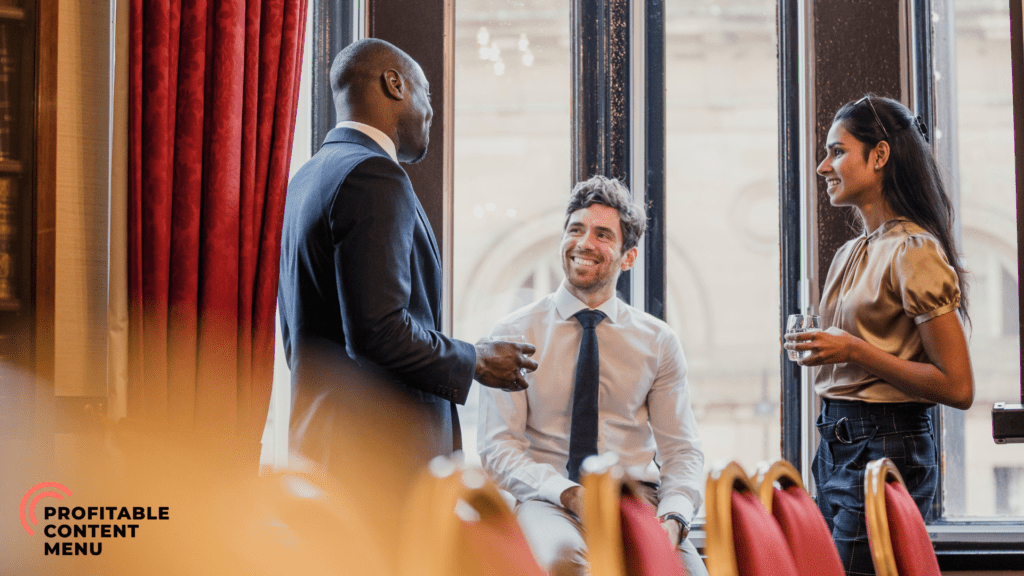I recently attended my first in-person professional networking event, and I must admit, I was a little anxious not knowing what to expect. In the end, I had a fabulous time, and it was wonderful to catch up with friends and colleagues live instead of over Zoom.
That got me thinking: As the country continues to reopen, we’ll be finding ourselves in more in-person networking settings. How do you navigate professional networking in a post-pandemic life? Should you hug, first bump or offer a handshake? How can you re-engage naturally after such an extended period of time?
For the answers to these questions and others, I turned to the best communications expert I know – Dianna Booher – to help me navigate these delicate times with some of her top communication and professional networking tips.
Dianna Booher helps organizations to communicate clearly and leaders to increase their influence by a strong executive presence – and sometimes with a published book. She is the bestselling author of 49 books, published in 62 foreign-language editions. Dianna doesn’t disappoint with her thoughtful guidance and practical tips. Check them out below to navigate your next networking event like the pro that you are!
Leona: Dianna, as I mentioned, people are getting out and about more and more. While they may have reconnected with friends and loved ones on a personal level, they may be a little bit more intimated to do that professionally. What advice would you give to those folks (like me!):
Dianna:
Let your body language do the talking! That is, most people read body language very well. If you’re ready to hug and get up close and personal with people, then by all means let others know that by opening yourself up for hugs. Put down the “toys” (backpacks, briefcases, iPads, or whatever you’re carrying) so that others see that a hug will be reciprocated. Open up your gestures, relax your posture, and extend your arms.
Doing the opposite of all these things sends the opposite message. That is, if you’re still not ready to get too close to other professionals, you can signal that by a closed posture (folded arms, remaining behind barriers like desks or devices, and so forth). And don’t forget the facial expressions – particularly the eyes. They can say “come here” or “stay away please.” Trust your colleagues to be perceptive!
Leona: Connecting in the office versus connecting in professional meetings or conferences can be different. How can you prepare yourself to make a smooth and natural transition at networking events?
Dianna:
To reconnect in a bigger circle like an industry meeting, consider connecting first by text, phone, or a virtual platform (even if that pre-connection is just a one-on-one Zoom chat). After having been out of circulation for more than a year-and-a-half, it definitely feels strange to walk into a room of 500 colleagues and start networking. Many will be even less confident giving a formal presentation or “taking the floor” to speak up in a meeting of even 7-10 people.
If your purpose is to persuade, you can build your confidence in these pre-meetings or “chats” by asking these individuals for their “input” before the “formal meeting.” What have you not thought of? What objections might “others” raise? What suggestions do they have for making your comments stronger in the “formal talk”?
People tend to support what they’ve invested in – even if that investment is simply time and ideas. Their support upfront will build your confidence.
Leona: What are your tips for shaking hands, fist/elbow bumps and physical touch in this day and age?
Dianna:
During the pandemic, other infectious illnesses like the flu and colds dropped dramatically. Physicians – and common sense – attribute this to mask-wearing and very limited physical touch. Although few would advocate wearing a mask for the rest of our lives, I think many people would sign on to the philosophy of less physical touch with strangers – especially during the winter months.
In my way of thinking, a polite nod and genuine smile to each other does wonders to deliver a warm welcome and make connections.
Leona: Dianna, what have you observed about how communication skills have changed – if any – as a result of the pandemic? Any interesting observations or insights? Will keen communications skills become more or less important now?
Dianna:
People have become much more aware of their own facial expressions during the pandemic. After watching yourself on Zoom for hours a day, your facial habits and tics have not escaped notice. For example, wrinkling the nose when you disagree with what someone says, scowling when you’re listening intently, rolling your eyes when you dislike the person speaking, twirling a twig of hair when nervous, staring up into blank space when thinking.
If you dislike any of these habits, awareness is the first step in changing them.
We all know the power of personal presence. What most need help with is how to increase their personal presence online! That’s just as important and often more difficult – whether we’re talking about being a meeting participant, a meeting facilitator or a social media contributor.
As to the overall importance of communication skills, nothing happens until somebody communicates – in person, in writing or online!
Leona: Have you observed any awkward moments or faux pas that you can help us steer clear of when it comes to communicating or even putting our best foot forward?
Dianna:
A big mistake: Being overly choregraphed! By that, I mean we have the technology to edit ourselves – or someone else edits us – for online production in webinars, seminars, or social media posts. So when others see or meet us in person, they don’t even recognize us. We look different. We sound different. The other person wonders who the online fake is. That kind of overly edited presentation of self is a big mistake. Authenticity matters.
Leona: Are there any books or resources that you’ve authored that would be a good refresher for us to read as we increase our professional connections and interactions?
Dianna:
Here are some resources I would recommend …
Communicate Like a Leader helps you add the polish when communicating with senior leaders.
Communicate With Confidence (Expanded Edition) provides 1,255 tips that address everything from small talk, to persuading, to connecting cross-culturally, to facilitating meetings. It’s my most comprehensive communication book.
Faster, Fewer, Better Emails will provide extensive help in this era when we write more than we speak to each other!
To learn more about Dianna, please contact her at www.BooherResearch.com or BooherBookCamp.com

